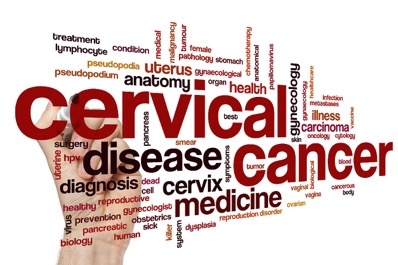Cancer. Everyone knows the word, and a mention of someone receiving a cancer diagnosis is usually closely followed up with the question of “What kind of cancer?” Could it be testicular cancer, breast cancer, prostate, or bone? Thanks to family care physicians, many cancers are detected early and can be treated successfully. One type of cancer that can be often detected during a female’s annual physical is cervical cancer.

The cervix is a narrow opening from the vagina to the uterus. Normally the portion that extends into the vagina, known as the ectocervix, is a healthy pink color and is covered with flat, thin cells called squamous cells. As the cervix moves into the uterus, the cells are different and are called columnar cells.
The area where these two types of cells meet is called the transformation zone and is the site where abnormal cells or precancerous cells most often develop. Most of the time, 80% or more of all cases of cervical cancer are squamous cell cancers.
Another type of cervical cancer is Adenocarcinoma that develops in the glands which produce mucous in the endocervix.
There are many cancers that are not considered to be preventable, but cervical cancer is a slow developing cancer that is one of the most preventable types of cancer. The only way to prevent cervical cancer is by having regular annual pelvic exams and Pap tests. Most women who end up with cervical cancer have not had a Pap test performed in 3-5 years.
Those abnormal and precancerous cells are detected quickly if a woman has a yearly exam. Cervical cancer seems to be most prevalent in middle-aged women, between 35 and 55 years of age.
HPV, or human papillomavirus, is found in around 99% of all cervical cancers. More than 70% of these cancers are caused by two types of HPV. HPV-16 and HPV-18 are considered to be high-risk HPV types.
There are more than 100 types of HPV, and most are considered to be low-risk and not causes of cervical cancer. HPV is a sexually transmitted infection and is the most common STI in the U.S. Many times, HPV is undetected and resolves itself within 2 years. Those women whose bodies do not clear the HPV virus are at greater risk of developing cervical cell abnormalities.

Regular screening can catch abnormal cells, but, if you haven’t had a screening recently, there is a chance that you may have precancerous cells that are causing symptoms to become noticeable. These symptoms include:
These symptoms could be related to cervical cancer, or they could be related to other sexual health problems. If you are having any of these symptoms, visit your physician immediately to determine the cause.
Knowing what cervical cancer is and how to prevent it is important for women of all ages. Avoiding HPV and having an annual physical are the best ways to prevent cervical cancer from forming. Weill Cornell has many knowledgeable physicians to help you with all of your medical health challenges and preventive care needs.